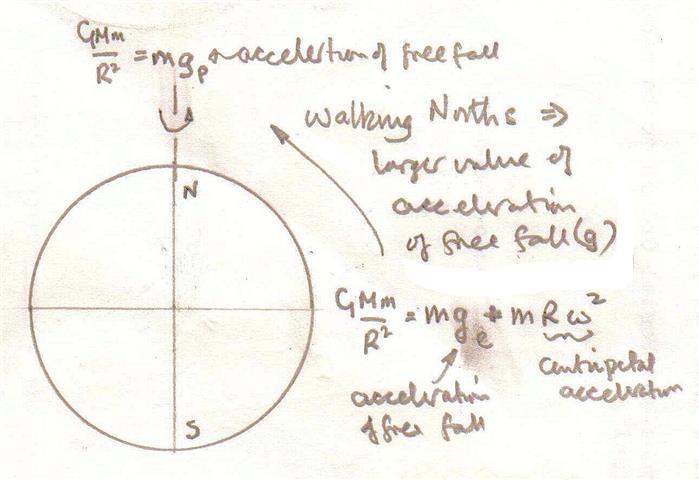We are told that Earth is spinning on its axis at 1037 mph— something that we don't usually feel because of the environment that moves with us as well. Is there any experiment with which we can know Earth's movement? Like levitating a helicopter for hours and landing it back down and checking the difference of distance moved? How can we detect Earth's spin? Any convenient answer would be highly appreciated.
-
1$\begingroup$ Related: physics.stackexchange.com/q/12487/2451 $\endgroup$– Qmechanic ♦Commented Feb 4, 2016 at 7:33
-
1$\begingroup$ you must ask a question about levitating a helicopter for hours ; it seems that you need good explainations of this configuration $\endgroup$– user46925Commented Feb 4, 2016 at 13:38
-
$\begingroup$ @igael right. besides stars there is already sun set/rise happening cause of rotation but we don't realize even 1 meter of 1037/mph with any experiment. anything like helicopter/baloon/drone which can levitate for hours should be effected by this rotation. $\endgroup$– HarryCommented Feb 4, 2016 at 16:31
-
$\begingroup$ on Pluton, without athmosphere , a flying object may be a little affected. On Earth, athmosphere makes the things a little bit more complex. In general, you may ignore the effect on an object not in contact with the ground. $\endgroup$– user46925Commented Feb 4, 2016 at 16:36
-
3$\begingroup$ You can't just take a helicopter, lift it in air and hold it in place: it's constantly being moved around by the air currents. If a helicopter wants to hover in place the pilot must make constant small adjustments to counter the effect of wind. There's no way for the pilot or any external observer to know if the helicopter is being moved by some force caused by Earth's rotation or just wind. The same thing applies to balloons, but even more: if you release a balloon and see where it is an hour later, it's wherever the winds have carried it. $\endgroup$– MoyliCommented Feb 4, 2016 at 17:48
2 Answers
How can we detect Earth's spin?
Apparent motion of Sun
You will have observed that the sun reappears every 24 hours. There are two common explanations for this. One of them is that the earth rotates with a period of approximately 24 hours - this is the only explanation supported by the scientific evidence. The main alternative had a rather convoluted way to explain retrograde motion of planets and, after the first observations of phases of Venus, had to be abandoned.
Apparent motion of stars
The simplest method is to look up at the stars at night and observe that their motion is consistent with the Earth rotating once in approximately 24 hours.
Foucalt pendulum
As CuriousOne commented, the Foucalt pendulum is another demonstration
A Foucalt pendulum at the north or south pole rotates 360$^\circ$ in a day. Elsewhere it's angular speed is $\omega=360\sin\varphi\ ^\circ/\mathrm{day}$ where $\varphi$ is the pendulum's latitude.
Coriolis effect
By observing large-scale weather patterns, you can detect the Coriolis effect
See also
-
$\begingroup$ @RedDrittyBrick, thanks for answering, with pendulum we observe minor movement of ball within half and hour but if we notice the stars they move faster in time lapsed video of half an hour, shouldn't they be accurate? how we can observe and measure 1037/mph from one point to another i guess pendulum doesn't do that. $\endgroup$– HarryCommented Feb 4, 2016 at 10:21
-
3$\begingroup$ @Harry: You just need to measure the rotational period of the Earth. You could do this using a Foucalt pendulum but it is easier to do so by measuring the interval from one sunrise to next. Then measure Earth's radius. You travel at a speed of 2 π r / day. For more exact measurements you need to take into account numerous other factors but this is a good start $\endgroup$ Commented Feb 4, 2016 at 10:55
Perhaps the least convenient but the most direct is go to the Moon and observe the Earth.
The (average) length of day as measured by timing stellar transit to stellar transit, sidereal day, differs by 4 minutes from the length of day defined by timing noon on one day to noon on the next day, solar day.
A satellite launched East requires less energy to get into orbit than a satellite launched West.
Changing from an inertial frame to a rotating frame introduces extra terms for acceleration resulting from “fictitious forces”.
The Foucault pendulum is a manifestation of one of these forces and is probably the most convenient direct evidence particularly if you have one set up in a local science museum.
Ignoring other effects there is a variation of the acceleration of free fall when travelling from the Equator to the Poles.
Dropping a stone from a tall building will result in the stone not falling vertically downwards.
An aeroplane flying due North ends up East of its target.






